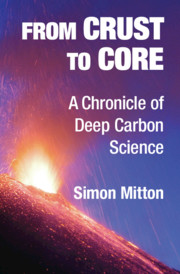Book contents
- From Crust to Core
- From Crust to Core
- Copyright page
- Dedication
- Contents
- Foreword
- Acknowledgments
- Introduction
- 1 Why Carbon in Earth Matters
- 2 The Origin of Deep Carbon in Deep Space
- 3 Deliveries of Cosmic Carbon Continue
- 4 On the Nature of Earth’s Interior
- 5 Earth’s Physical Interior Revealed
- 6 Thousands, Millions or Billions
- 7 Physics and Chemistry of Deep Earth
- 8 Confronting the Continental Drift Conundrum
- 9 The Mid-Atlantic Ridge and Rift Valley
- 10 Earth’s Deep Dynamics Discovered
- 11 Reversals of Fortune
- 12 Deep Carbon
- 13 Carbon-Bearing Phases in the Mantle
- 14 Diamond in the Mantle
- 15 Deep Life
- Glossary
- Biographical Notes
- Index
- References
10 - Earth’s Deep Dynamics Discovered
Published online by Cambridge University Press: 19 December 2020
- From Crust to Core
- From Crust to Core
- Copyright page
- Dedication
- Contents
- Foreword
- Acknowledgments
- Introduction
- 1 Why Carbon in Earth Matters
- 2 The Origin of Deep Carbon in Deep Space
- 3 Deliveries of Cosmic Carbon Continue
- 4 On the Nature of Earth’s Interior
- 5 Earth’s Physical Interior Revealed
- 6 Thousands, Millions or Billions
- 7 Physics and Chemistry of Deep Earth
- 8 Confronting the Continental Drift Conundrum
- 9 The Mid-Atlantic Ridge and Rift Valley
- 10 Earth’s Deep Dynamics Discovered
- 11 Reversals of Fortune
- 12 Deep Carbon
- 13 Carbon-Bearing Phases in the Mantle
- 14 Diamond in the Mantle
- 15 Deep Life
- Glossary
- Biographical Notes
- Index
- References
Summary
The previous chapter described the genesis of a new interdisciplinary field, oceanography, which led to enormous advances in broadening our understanding of the history of the ocean basins. Seafloor spreading at the ocean central ridges and the ancient seafloor descending into the trenches at the ocean margins were the key conceptual breakthroughs for discovering the interior dynamics of the Earth system. But turning that imaginative concept of a dynamic Earth into a realistic package of evidence, as required by the scientific method, continued to be elusive in the 1950s and early 1960s. As is often the case in the history of Earth science, though, the convincing evidence eventually came from two unexpected but related lines of investigation: studies of rock magnetism and magnetic surveys of the seafloor. Investigation and follow-up of the phenomena in these fields turned out to be of critical importance for reconstructing the history of the motions of portions of the terrestrial surface. This is a tale of serendipity, in which research on the magnetic record fossilized in rocks finally led to the seal of approval for a brilliant concept: plate tectonics. I’ll begin with the puzzle of how and where the geomagnetic field is generated. The properties of the geomagnetic field are observable from surface measurements of its direction, strength and variations.
- Type
- Chapter
- Information
- From Crust to CoreA Chronicle of Deep Carbon Science, pp. 194 - 210Publisher: Cambridge University PressPrint publication year: 2020

